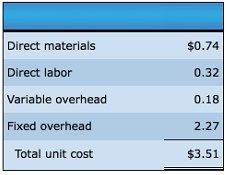Assignment:
Could you please help me solve for operating income?
Organizations are often faced with a make-or-buy decision-a decision of whether to make or to buy components or services used in making a product or providing a service. For example, a factory can make a component for a product in-house or purchase it from an outside supplier.
Example: Each year, Ingmar Company produces 12,000 units of a component used in microwave ovens. An outside supplier has offered to supply the part for $1.41.
The unit cost is: Round intermediate calculations to the nearest cent. Use rounded answers in subsequent computations, if required.

The alternatives for Ingmar Company are: continue making the component in-house, or purchasing the component from the outside supplier. Assuming that none of the fixed cost is avoidable, determine which alternative is more cost effective: Make the component in-house If Ingmar accepts the offer to purchase from the outside supplier, operating income will be Now supposing that Ingmar Company rents machinery capable of making 12,000 units of the component per year and the annual lease cost is $12,000 (this is included in the fixed overhead for the component).
the lease can be cancelled whenever Ingmar wants without penalty. the machinery lease cost is relevant. Determine which alternative is more cost effective: Purchase from the outside supplier If Ingmar accepts the offer to purchase from the outside supplier, operating income will be $ the make-or-buy decision may be more complex than either example noted above.
However, the key idea is that relevant costs and benefits must be distinguished from irrelevant costs and benefits. Therefore, no matter how many costs are involved, the analyst can determine the overall quantitative impact of making versus buying.
Finally, the qualitative factors must be considered. For example, perhaps Ingmar Company believes that it can do a higher quality job than the outside supplier.
Then, even if it were less expensive to purchase outside, the company could continue to make the component in-house. Or, perhaps Ingmar Company could use the freed-up space and workers to make a new, potentially very profitable, product. Then the company might decide to outsource the component even if it appears in the short-run to be a costlier approach.